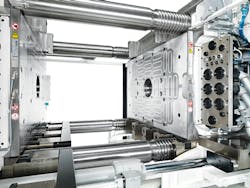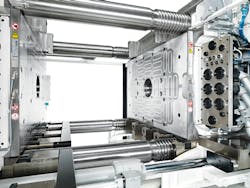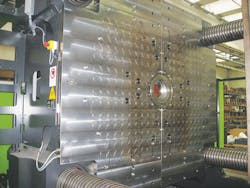NPE: Magnetic clamping systems advance as mold-changing option
Quick mold changes have been the primary selling point for magnetic mold mounting systems as an alternative to bolt-on mechanical clamping or hydraulic mold-clamping approaches. Suppliers of magnetic clamping systems expect to attract additional processors with design updates that further reduce downtime and labor costs related to mold changeovers while increasing operator safety.
Suppliers of permanent electromagnetic systems change the polarity of the magnet by applying a brief charge of electric current into a specially designed platen to clamp or unclamp the mold. Applying the electric current extends the magnetic field of the permanent magnet system several millimeters from the platen into an adapter plate attached to the mold. The magnetic field pulls back into the platen during mold unclamping.
The continuous, uniform force that the magnet generates tightly clamps the platen to the steel mold adapter plate, preventing mold deflection. At the same time, the short depth of the magnetic field into the mold does not interfere with other aspects of the tool, such as the cores, ejector pins or thermocouples. Magnetic clamping systems only clamp and unclamp when a charge from the system is sent; hence, a power outage or lightning strike has no effect on the mounting force of the clamping system.
The magnetic force generated is capable of holding molds weighing tens of tons.
Magnetic platens are designed for mounting using locator-ring patterns approved by SPI, Euromap and Japanese Industrial Standards. The platens are compatible with non-standard tool configurations and not limited by bolt-hole patterns, requiring only a standard locator ring. To operate with peak magnetic holding force, suppliers say the adapter back-plate must be composed of a non-alloyed tool steel, be absolutely flat to mount flush against the platen, and be free of oil, dirt and rust.
Suppliers such as EAS Mold & Die Change Systems Inc., Tecnomagnete Inc., Carr Lane Roemheld Mfg. Co., and Stäubli Corp., Duncan, S.C., have installed magnetic clamping systems in thousands of horizontal and vertical presses operating in North America over the last couple of decades.
MAGNET SYSTEM RECONFIGURED
FOR LARGE MACHINES
EAS, Menomonee Falls., Wis., introduced a new electro-permanent magnetic clamping system for injection molding presses with clamping forces of 440 to 4,950 tons. The system can reduce the changeover time of a 40-ton mold from several hours to less than 3 minutes.
The new EAS Pressmag LP system incorporates a series of design updates that improve upon the high clamping performance and control offered with EAS' Pressmag HP system for large injection machines. Pressmag LP incorporates long-pole technology that delivers a higher holding force (magnetic flux) while minimizing stray flux and air gaps, which can occur between the clamping system and mold when the tool is not flat.
When activated, the long pole becomes the north pole and the frame plate becomes the south pole, says Vincent Nijzink, president of EAS. EAS Pressmag systems incorporate magnets made from neodymium and alnico, an alloy of iron, aluminum, nickel and copper.
The Pressmag LP design uses alnico pole magnets and a coil wrap, but incorporates metal between the poles rather than epoxy, which is used with the Pressmag HP design. Pressmag LP also moves away from the rectangular pole shape used in the Pressmag HP design and instead incorporates a new oval-shaped pole configuration (long pole with a rounded end) that is pre-assembled and plug-in ready. The design updates enhance the coverage area of the magnet 20 to 25 percent, while the snap-in, oval poles simplify changeout and exchange during maintenance. The new pole design of the LP line gives stiffness to the frame; results in a better flux density and higher clamping force; reduces possible connection issues; and places mounting holes where they do not reduce the magnetic surface.
The LP and HP designs generate 2.1 tons of clamping force per pole, which is concentrated on the mold back plates and not into the machine platens, says Nijzink. Both Pressmag LP and Pressmag HP systems require a mold back plate with a minimum thickness of 1.8 inches and maximum thickness of 2.15 inches. The magnet systems generate a magnetic flux depth of 0.98 inch (25mm) and operate in environments with temperatures up to 212 degrees Fahrenheit.
The new Pressmag LP system features a magnetic flux sensor and two proximity sensors embedded into the platen as standard for magnetic flux and exact clamping force measurement. A newly designed cable connection box installed in the platen simplifies access to the wire connections. EAS systems utilize standard voltages to operate magnetic clamp up and unclamp.
Pressmag LP also has a new MAGTCU 13 touch-screen controller rather than the standard control unit used with the HP model. The controller, tested and approved by Apave International, a Paris-based ISO testing service, provides magnetizing status and magnetic flux on fixed and movable plates, and displays a status of the proximity sensor, temperature sensor and system alarms. The unit automatically performs system diagnostics and adapts to varying electric power conditions. Other features include a removable SD card for offline system troubleshooting and an 8-inch touch-screen control.
EAS also introduced a new double mold change table for tooling changeovers. It holds two molds, making the second mold instantly available for exchange in the machine. Laser-defined positioning provides simpler, faster and more precise positioning of the mold table and allows for smooth mold transfers. A single drive operates the chain transmission of multiple tables for reliability and reduced cost.
MONOLITHIC MAGNETISM
Tecnomagnete, Sterling Heights, Mich., says its PressTec Grip system magnetically clamps the mold and machine platens to it to form, in essence, a single block of steel that is absolutely rigid and avoids vibration of deflection, which allows for high molding precision and part quality. This latest system, introduced in Europe at K 2013 and displayed for the first time in North America at NPE, produces a solid surface magnetic plate that protects the components inside the plates. This design helps minimize leaks that can penetrate the coil and potentially short-circuit the system, says Pete Moorhead, operations manager at Tecnomagnete.
The PressTec Grip system is built from the back side, rather than from the front, creating a monolithic solid surface with the magnetic plate and tool that eliminates the potential problem. "We still use bolts to attach the magnets to the machine platens, but the grip function provides 35 to 45 percent holding force out of the back of the magnetic plate to secure the system and to maintain the best parting line in your tools," Moorhead says.
Tecnomagnete's updated PressTec Grip system is based on its patented Quadsystem Monolite technology, a new generation of alnico and neodymium magnets and components that feature no moving parts and circular polar areas that create a fully metallic, solid block structure as a monolithic working surface. The absence of inserts or moving parts eliminates possible wear and protects the electric circuits and magnets, which can lead to longer operating life.
The honeycomb structure of the PressTec platen keeps thermal coefficient and mechanical resistance constant. A mold plate thickness of 1.46 inches lowers the weight of the plate on the platen — versus competing systems that require thicker plates — and allows more daylight in the press. That reduced thickness also has increased the popularity of retrofitting machines, Moorhead says. "This gives brand-new machine platen surfaces and eliminates maintenance on worn and unreliable threaded holes in existing platens," he says.
Tecnomagnete's bidirectional magnetic circuit generates up to 99 tons per square meter of magnetic force on the mold contact area. The monolithic structure and magnetic force allow the tool to be operated safely even in the presence of air gaps, with no stray fluctuations, and in operating conditions up to 248 degrees Fahrenheit.
The system can be run with a standard remote keypad unit with push buttons or with Tecnomagnete's interactive color touch-screen that detects the actual clamping force, the quality of the contact and the thickness of the material of the mold base plate.
Step-by-step procedures for mold installation and machine startup are included, and mold data can be logged. The value of force can be recorded for specific molds as a reference for subsequent operations. The control prohibits machine startup if the magnetic force does not reach a threshold value, says Moorhead.
Because the automotive industry is moving toward larger machines, Tecnomagnete is also installing its systems on larger presses. "We currently have systems on several 4,400-ton machines," Moorhead says. Growth in the automotive sector will translate into stronger sales for systems compared with 2014, according to Moorhead.
HIGH CLAMPING IN HIGH-TEMPERATURE
ENVIRONMENTS
The Hilma Division of Carr Lane Roemheld Mfg. Co., Fenton, Mo., says its M-TECS 130 magnetic clamping system, which is designed to withstand operating temperatures up to 266 degrees Fahrenheit, now delivers up to 20 percent more clamping force versus older designs. The company also offers its M-TECS 210 (410 degrees Fahrenheit operating temperature) for rubber compression molding operations, says manager Dave Fischer.
The company introduced the new M2C controller for the M-TECS 130 system at NPE. Hilma says it improves safety and has greater ability to be serviced, compared to the prior controller. Included is more sensitive and responsive mold-movement detection and monitoring of the current to the platen and system temperatures. The M2C provides more feedback to the operator regarding the status and performance of the clamping system.
Hilma utilizes long-pole technology, incorporating double magnets, to bump up the clamp force. With the magnetic systems, the time to change molds of different sizes can be as quick as a minute and doesn't require retooling. Electrical power is required for 2 seconds to unclamp the tool from the platen. Because the custom-designed clamping systems evenly distribute the magnetic force across the clamping surface, tool wear is reduced considerably, says Fischer.
The design and magnetic forces required can be adjusted as needed for the application. The mold plates have a thickness of 55mm. The system provides magnetic penetration of 15mm to 20mm, and each specific magnet builds up a clamping force of 256 pounds per square inch. The M-TECS system features two electro-permanent magnet plates, a control system, remote control unit and a complete set of cables including plug-in type connections that connect the unit to the injection machine. The company also offers hydraulic, mechanical-electric and hydro-mechanical clamping systems, says Fischer.
Mikell Knights, senior correspondent
Contact:
Carr Lane Roemheld Mfg. Co., 636-386-8022, www.clrh.com/hilma
EAS Mold & Die Change Systems Inc., 262-783-7955, www.EASchangesystems.com
Tecnomagnete Inc., 586-276-6001, www.tecnomagnete.com



